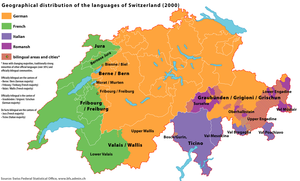German-speaking Switzerland
This article needs additional citations for verification. (June 2021) |

High Alemannic dialects; marked in red is the Brünig-Napf-Reuss line
.
The German-speaking part of Switzerland (German: Deutschschweiz, French: Suisse alémanique, Italian: Svizzera tedesca, Romansh: Svizra tudestga) comprises about 65 percent of Switzerland (North Western Switzerland, Eastern Switzerland, Central Switzerland, most of the Swiss Plateau and the greater part of the Swiss Alps).
The variety of the
Austro-Bavarian dialect
is spoken.
German is the sole official language in 17 Swiss cantons (
Graubünden, more than half the population speaks German, while most of the rest speak one of the other official languages, Romansh and Italian
.
While the French-speaking Swiss prefer to call themselves Romands and their part of the country la Walha). In Germany Welsch and Welschland refer to Italy; there, the term is antiquated, rarely used, and somewhat disparaging.
By the
Reformation
, all cantons were either Catholic or Protestant, and the denominational influences on culture added to the differences. Even today, where all cantons are somewhat denominationally mixed, the different historical denominations can be seen in the mountain villages, where Roman Catholic Central Switzerland abounds with chapels and statues of saints, and the farm houses in the very similar landscape of the Protestant Bernese Oberland show Bible verses carved on the housefronts, instead.
See also
- German-speaking Europe
- Languages of Switzerland
- Swiss German
- Swiss Standard German
References
- ^ "The Federal Constitution of the Swiss Confederation, article 1". Archived from the original on 2014-10-04. Retrieved 2009-05-01.

